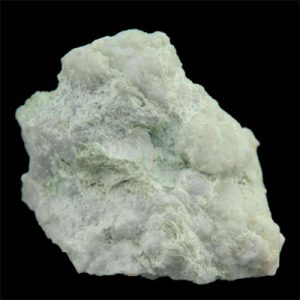Magnesite: Gemstone Information
Magnesite is MgCO3; crystals are rare, the common occurrence being as translucent, sometimes transparent colorless, white, yellowish to brown or grey masses with an earthy or chalky appearance. The crystal system is trigonal; there is one direction of perfect cleavage and the hardness is 3.5–4.5 with SG 3.0–3.1. The RI for the ordinary and extraordinary rays is 1.710 and 1.509, uniaxial negative with birefringence 0.202, very easy to see in the occasional faceted specimen. Under SWUV blue green or white fluorescence may be seen with greenish phosphorescence. Magnesite occurs as a primary mineral in igneous or sedimentary rocks or may be formed by the metamorphism or alteration of serpentine and peridotite. Fine crystals come from Brumado, Bahia, Brazil.
Magnesite: Unveiling its Beauty and Benefits
Introduction:
Magnesite, a fascinating gemstone with a rich history and a myriad of benefits, has captured the attention of gem enthusiasts worldwide. This mineral, composed of magnesium carbonate, boasts a distinctive appearance and a range of properties that make it both visually appealing and spiritually significant. Join us as we explore the origins, characteristics, and benefits of magnesite.
Origin and Composition:
Magnesite derives its name from its high magnesium content, a key component of its chemical composition. This mineral forms in sedimentary rocks through the alteration of magnesium-rich rocks or the precipitation of magnesium carbonate from groundwater. Magnesite typically occurs in white, gray, or cream-colored masses, occasionally displaying intricate patterns and veining.
Properties of Magnesite:
1. Color and Appearance: Magnesite is known for its soft, pastel hues, ranging from creamy white to pale gray. Some specimens may exhibit streaks or patches of brown, yellow, or gray, adding depth and character to the stone. Its luster is typically dull to waxy, with a smooth texture when polished.
2. Hardness and Durability: On the Mohs scale of mineral hardness, magnesite registers between 3.5 and 4.5, making it relatively soft compared to other gemstones. As a result, it requires gentle handling to prevent scratching or damage. Despite its softness, magnesite can still be fashioned into jewelry with proper care.
3. Transparency and Clarity: Magnesite is often opaque, with limited translucency in certain specimens. While high-quality magnesite may exhibit better clarity, it is generally valued for its overall appearance rather than its transparency.
4. Cut and Shape: Magnesite is commonly fashioned into beads, cabochons, and carved figurines due to its softness and ease of shaping. Its malleable nature allows artisans to create intricate designs and patterns, showcasing the stone’s natural beauty.
Benefits and Uses:
1. Spiritual and Emotional Healing: Magnesite is believed to possess calming and grounding properties, making it a popular choice for spiritual practitioners and individuals seeking emotional balance. It is thought to soothe feelings of anxiety, stress, and nervousness, promoting a sense of tranquility and inner peace.
2. Enhanced Meditation and Awareness: Some people use magnesite during meditation to deepen their connection to the spiritual realm and heighten their awareness of the present moment. Its gentle energy is said to facilitate introspection and self-reflection, aiding in the release of negative emotions and thought patterns.
3. Physical Healing Properties: In crystal healing practices, magnesite is associated with the treatment of various physical ailments, including headaches, migraines, and muscle cramps. It is believed to alleviate tension and promote relaxation, supporting overall well-being and vitality.
4. Chakra Alignment: Magnesite is often associated with the third eye and crown chakras, which are believed to govern intuition, spirituality, and higher consciousness. By balancing and aligning these energy centers, magnesite is thought to enhance spiritual clarity, intuition, and psychic abilities.
Conclusion:
Magnesite, with its gentle beauty and profound healing properties, continues to captivate individuals seeking solace, balance, and spiritual growth. Whether admired for its aesthetic appeal or cherished for its therapeutic benefits, this versatile gemstone serves as a reminder of the interconnectedness between the physical, emotional, and spiritual aspects of our being. Incorporating magnesite into daily rituals, meditation practices, or jewelry collections can enrich one’s life with its soothing energy and transformative potential.





